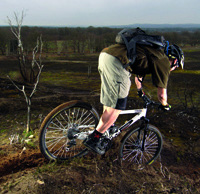 FRAME
FRAME
Like all the Meta frames, the Combi S doesn’t really use hydroformed or manipulated tubing. There’s a bit of shaping on the back of the top tube but all the pipes are conventional round stuff. This means that to get the stiffness, especially in the front end, Commençal has had to increase the size and thickness of the tubes.
It’s claiming a frame weight of around 3kg without shock or 6-7lb with a RockShox Bar 2.1 shock. At 15kg (33.2lb) the Combi S is the heaviest bike here. Commençal freely admits the frame isn’t light but points out that it passes the latest EN standard, so should go the distance.
On the latest Meta frames Commençal has updated the design with a single beam swingarm.
This older design has a triangular structure, which we feel doesn’t give that much away in terms of stiffnessand is visually more appealing. To create space for the links and pivot, and to boost stiffness, Commençal mounts the front derailleur on a swingarm stub. Front derailleur cable routing is still a mess; it bends sharply round the bottom bracket, and routes over the front derailleur before ending with a 90-degree turn on the lower yoke.
SUSPENSION
Commençal is the odd man out, fitting a RockShox Dart 2 fork on the Combi S. In Europe this bike comes with a SunTour fork, but importer Madison decided on a RockShox because it was worried about spares availability. Whatever, this is a fork we see a lot on Dirty Dozen bikes and while it has a steel steerer and stanchions like the Tora specced elsewhere, it’s got flexier 28mm chrome steel stanchions and comes out heavier at 2.4g (5.5lb). The fork never achieved the stipulated 100mm of travel and unsurprisingly for a coil fork had a hard, stiff action.
The Combi S is a single pivot with a (Contact System) linkage-activated shock. The reason for the links is to isolate the shock from any side-loading, house it inside the main triangle away from the mud and generally increase bearing life. On our test bike, the lower bushing on the shock still came loose after 20 miles but reassembling the bushing and bolt with a drop of Loctite seemed to cure it.
PERFORMANCE
It’s a good thing the fork doesn’t move much, because we’d have been hitting the end of the crank with every pedal revolution if it did.
Tell-tale marks on the end of the Truvativ Isoflow cranks show the bottom bracket is far too low, at 31cm (12.25in). A low bottom bracket is great for cornering as you’re lower to the ground and more stable, but grounding a pedal on every root or technical climb is really annoying.
Like the Giant, the Commençal shock absorbs bigger hits really well and feels at home on rougher tracks — in this respect it seems to have more than the stated 100mm of rear travel. The same cannot be said of the fork, which is really harsh and barely moved. We’d forget to shift it out of the way of an obstacle and feel a sharp jolt through our forearms. We felt more fatigue riding this bike than any other and it’s all down to the Dart 2 fork.
VERDICT
Two things really hurt the Combi S: the geometry and the entry-level Dart fork. While the latter is a relatively easy thing to fix, there’s not really a lot you can do about the former. Fitting a longer travel fork may correct some of the issues with the bottom bracket height but it can have a knock-on effect on top tube length, which is already short. If this seems familiar, it’s because we’ve had geometry issues with the latest Meta 5 in the Trail Bike of the Year test, Danny’s longtermer and the Meta 666. None of the geometry tallies with printed figures or previous bikes we’ve measured, which isn’t a bad thing if it adds up — unfortunately, on the Combi S it doesn’t.
MBR RATING: 7/10



